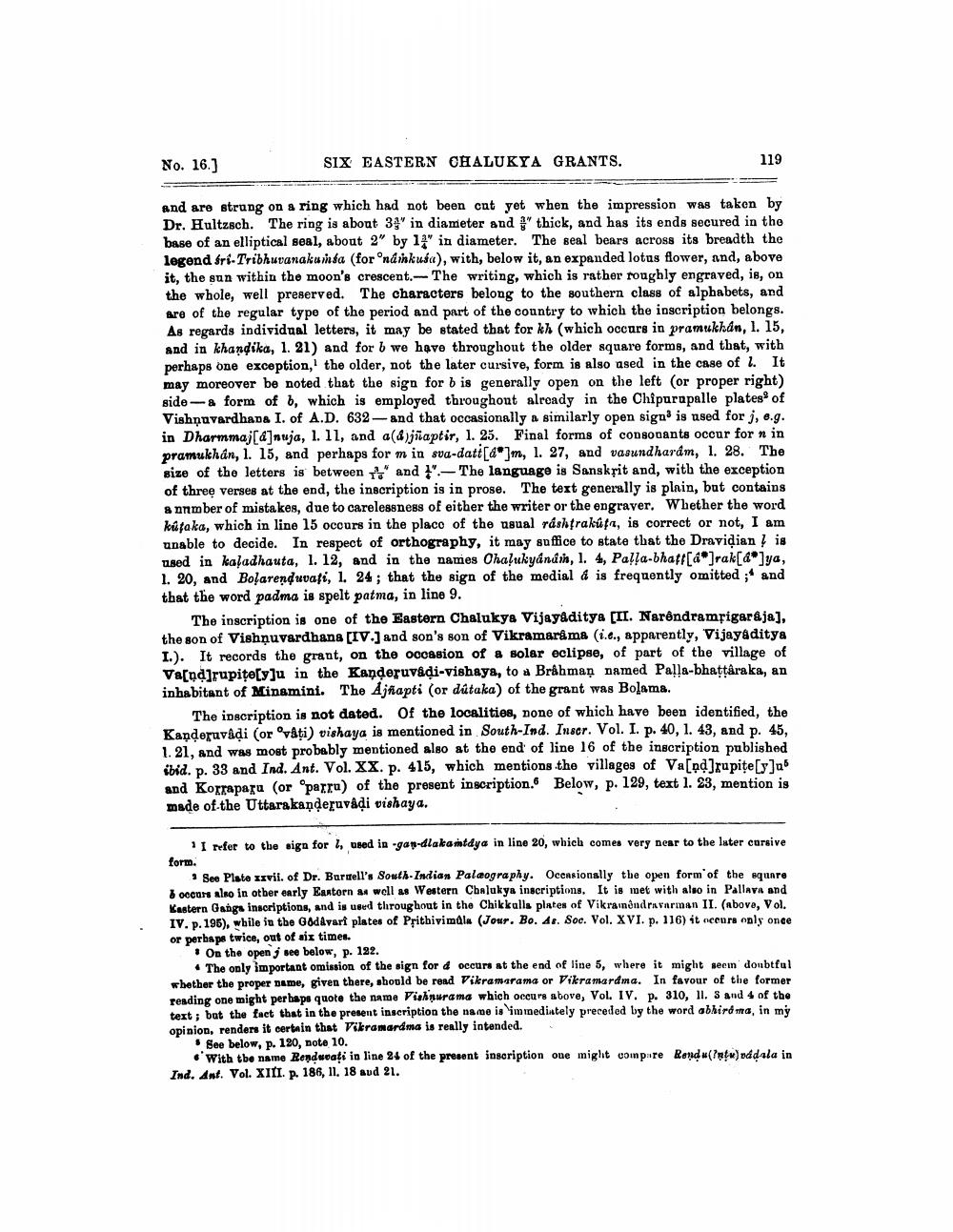________________
No. 16.)
SIX EASTERN CHALUKYA GRANTS.
119
and are strung on a ring which had not been cat yet when the impression was taken by Dr. Hultzsch. The ring is about 3' in diameter and 3" thick, and has its ends secured in the base of an elliptical seal, about 2' by 14" in diameter. The seal bears across its breadth the legend fri-Tribhuvanaku inda (for ondinkusa), with, below it, an expanded lotus flower, and, above it, the sun within the moon's crescent. The writing, which is rather roughly engraved, is, on the whole, well preserved. The characters belong to the southern class of alphabets, and are of the regular type of the period and part of the country to which the inscription belongs. As regards individual letters, it may be stated that for kh (which occurs in pramukhan, 1. 15, and in khandika, 1. 21) and for b we have throughout the older square forms, and that, with perhaps one exception, the older, not the later cursive, form is also ased in the case of l. It may moreover be noted that the sign for b is generally open on the left (or proper right) side-a form of b, which is employed throughout already in the Chipurapalle plates of Vishnuvardhana I. of A.D. 632- and that occasionally a similarly open sigu' is used for j, e.g. in Dharmmaj[á]nuja, 1. 11, and a&jīlaptir, 1. 25. Final forms of consonants occur forn in pramukhán, 1. 15, and perhaps for min sva-dati[]m, l. 27, and vasundharam, 1. 28. The Bize of the letters is between " and "--The language is Sanskrit and, with the exception of three verses at the end, the inscription is in prose. The text generally is plain, but contains annmber of mistakes, due to carelessness of either the writer or the engraver. Whether the word küfaka, which in line 15 occurs in the placo of the usual ráshtrakúfr, is correct or not, I am unable to decide. In respect of orthography, it may suffice to state that the Dravidian is used in kaladhauta, l. 12, and in the names Ohalukyanán, 1. 4, Paļļa-bhaff[]rak[do]ya, 1. 20, and Bolarenduvati, 1. 24; that the sign of the medial á is frequently omitted ;' and that the word padma is spelt patma, in line 9.
The inscription is one of the Eastern Chalukya Vijayaditya [II. Narendramrigaraja], the son of Vishnuvardhana (IV.) and son's son of Vikramarama (i..., apparently, Vijayaditya I.). It records the grant, on the occasion of a solar eclipse, of part of the village of Va[nd]rupite[y]u in the Kanderuvadi-vishaya, to a Brahman named Palla-bhattâraka, an inhabitant of Minamini. The Ajfapti (or dútaka) of the grant was Bolama.
The inscription is not dated. Of the localities, none of which have been identified, the Kandoruvadi (or váți) vishaya is mentioned in South-Ind. Inscr. Vol. I. p. 40, 1. 43, and p. 45, 1.21, and was most probably mentioned also at the end of line 16 of the inscription published ibid. p. 33 and Ind. Ant. Vol. XX. p. 415, which mentions the villages of Va[nd]rupitelylab and Korrapasu (or opatra) of the present inscription. Below, p. 129, text l. 23, mention is made of the Uttarakanderuvadi vishaya.
* I refer to the sign for 1 used in-gap-dlakamtdya in line 20, which comes very near to the later cursive form.
See Plate Xivil. of Dr. Barcell's South Indian Palaography. Ocensionally the open form of the square occan also in otber early Eastern as well as Western Chalukya inscriptions. It is met with also in Pallava and Kastern Gaiga inscriptions, and is used throughout in the Chikkulla plates of Vikra nêndravarman II. (above, Vol. IV. p. 195), while in the Godavari plates of Prithivimala (Jour. Bo. 41. Soe. Vol. XVI. p. 116) it occurs only once or perhaps twice, out of six times.
On the open y see below, p. 122.
• The only important omission of the sign for & occurs at the end of line 5, where it might secun doubtful whether the proper dame, given there, should be read Vikramarama or Vikramardma. In favour of the former reading one might perhaps quote the name Vishnurama which occurs above, Vol. IV. p. 310, II. S and 4 of the text; but the fact that in the present inscription the name is immediately preceded by the word abhirama, in my opinion, renders it certain that Vikranardma is really intended.
See below, p. 120, note 10.
. With tbe name Renduvati in line 24 of the present inscription one might compare Rondu(?mtw) oddala in Ind. Ant. Vol. XIII. p. 186, 11, 18 avd 21.




